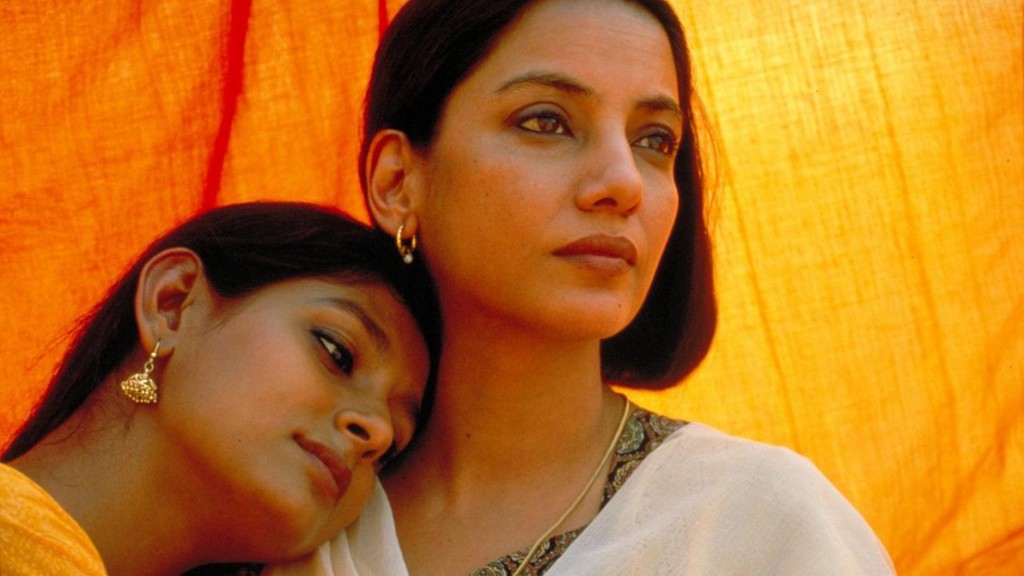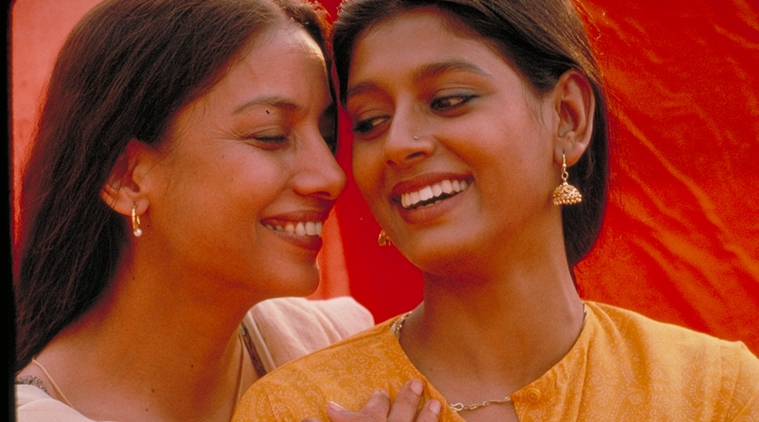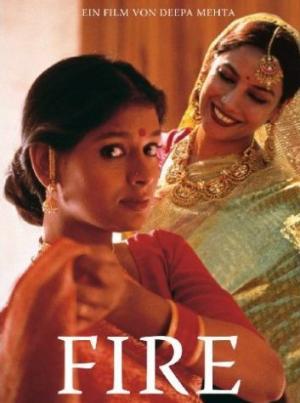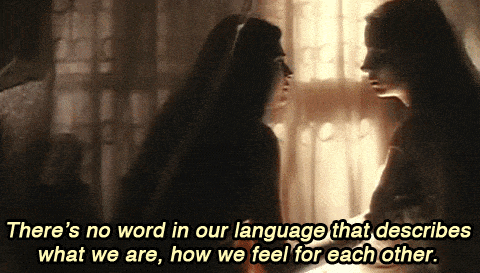Deepa Mehta’s Fire is a rare Bollywood film that puts forth the discussion about one of the secrets of the contemporary Indian society: the sexual orientation of its subjects, with a prime focus on women, a community that faces severe marginalisation and oppression in a patriarchal societal structure. It is loosely based on Ismat Chughtai’s 1942 story, called Lihaaf (The Quilt) and was one of the first Bollywood films that explored the theme of homosexuality. Fire revolves around the relationship between two women, namely Sita and Radha played by Nandita Das and Shabana Azmi, respectively.

Fire opens with a young Radha complaining to her mother about her inability to see the ocean, to which her mother replies, “What you can’t see, you can see.” When one tries to analyze this with reference to Radha’s life, it could only mean that even though she couldn’t lead a happy life with her husband, Ashok (played by Kulbushan Kharbanda), she was able to do so through her relationship with Sita.
The Journeys Of Sita And Radha
Both Sita and Radha have been portrayed as women who are not happy in their married lives. Radha is portrayed as a ‘barren’ woman, whose role is only limited to looking after Ashok and his mother, managing his shop and performing the household chores because she can’t perform the most important aspect of a marital relationship – procreation and the role of being a mother.
Sita on the other hand, is portrayed as a young woman with progressive ideals, who is unhappy with her married life because her husband is seeing another woman. Experiencing the lack of attention from their husbands, Sita and Radha start spending their time together and finally end up developing a sexual relationship with each other as a consequence of their doomed marriages. Their relationship with each other is a means through which they experience the love which they deserve, the love which they could not get from their husbands.

This form of love is new to them, as Radha tells Sita – “this isn’t familiar to me, this awareness of needs and desires.” However, this is the only part about the movie which is unsettling, the notion that these women get to explore their sexualities as a consequence of the unhappiness arising from their failed marriages. The movie also portrays how women are denied a control over their own sexualities, and in case they decide to explore their sexualities, they are shunned from the society and are given titles like “shameless whore.”
Exploring Female Sexuality
Fire is also an apt representation of the suppression of female sexuality and the denial of a woman’s agency in a patriarchal society that normalizes the representation of women as mere objects and ensures their subjugation by men. Soon after her marriage with Jatin (played by Javed Jaffrey), she is told by her brother-in- law, Ashok that once she has a baby, it will be a full-time job, pointing towards the stereotype that the role of women is only restricted to taking care of her children and her husband’s family, once she is married.
On the other hand, Sita tells Radha that she has been taught by her mother that, “a woman without a husband is like plain rice: bland and unappetizing“. She further adds that she believes this must be an Indian saying, pointing towards the status of women in the Indian society.
Additionally, in a scene that depicts Sita and Radha in the marketplace discussing their ideas about marriage, Radha tells Sita that she has grown up listening that, “the way to a husband’s heart is through his stomach” and adds that she thinks it must be an English saying. On the other hand, Sita tells Radha that she has been taught by her mother that, “a woman without a husband is like plain rice: bland and unappetizing“. She further adds that she believes this must be an Indian saying, pointing towards the status of women in the Indian society.

Radha responds that she likes bland rice, implying her dejection at the state of her married life and a desire to withdraw from that state. Furthermore, when Sita asks Jatin if he is occupied somewhere, meaning whether he is involved in an extra-marital affair, he replies that she is the one who needs to be occupied and asks her to take up some needlework or embroidery in order to pass her time. This reply on the part of Jatin is reflective of gender roles being assigned to men and women in the society, not only in terms of their responsibilities towards their families and children, but also with regards to the occupations and hobbies that they are expected to pursue. Women are expected to engage in arts like needlework and embroidery because of the common notion of femininity being associated with such activities.
Cultural Patriarchy And The Patriarchal Culture
Furthermore, the movie also portrays how women are expected to follow the cultures and traditions of their husbands’ family once they get married. A scene depicts Radha and Sita observing the fast of Karvachauth for the long lives of their respective husbands. Sita did not want to observe the fast, but it is apparent that she did not have a choice. Thus, expressing her discontent to Radha she says, “Isn’t it strange that we are so bound by customs and traditions that somebody just has to press my button, a button marked tradition, and I start responding like a trained monkey.” In reply, Radha explains the history of the tradition to Sita and finally says, “The only reason why we are expected to observe this fast is to prove how loyal and devoted we are to our husbands.”

The domestic realm of a household is not the only domain which promotes the suppression of female sexuality, but other spheres of human interaction such as religion, nation, family, kinship etc. also come to play when we talk about the same. Despite the few advances in the gender roles in the twenty first century, the stereotype that men are sexually ardent and women are sexually passive if not repressed, is still the social norm. We cannot ignore the Madonna-Whore Dichotomy when we talk about this issue.
Also read: Book Review: Unruly Visions: The Aesthetic Practices Of Queer Diaspora By Gayatri Gopinath
Sigmund Freud developed a theory where men place women into two categories – Madonna, a woman who is admired and respected, and the whore, a woman who men are attracted to, and thus disrespect. This theory is called the Madonna-Whore complex which, according to Freud represents the uncomfortable dichotomy of fear and desire, explaining the anxiety that men experience towards women’s sexuality. This dichotomy is apparent in many relationships where men generally aspire to keep the image of their romantic partner as Madonna, but at the same time, seek the ‘whore’ in the form of an affair to achieve both the traits that are difficult to project onto the same woman.
When analyzed carefully, we observe the elements of the Madonna-Whore Dichotomy operating in the movie. Even though Radha is unable to procreate, she is treated respectfully by her husband, Ashok. Similarly, in the initial stages of the movie, Sita is shown to be treated respectfully by Jatin, but is not desired because he already has an affair with an another woman.
Many feminists argue that the dichotomy stems from a desire to reinforce patriarchy into the society and suggest that this patriarchal arrangement has negative implications for both men as well as women. Although this theory given by Freud is widely considered as sexist and a misogynistic idea, but it is still widely pervasive in the modern understanding of gender roles. Women are shamed for expressing their sexuality, but are simultaneously valued for their attractiveness and overall femininity by the society. When analyzed carefully, we observe the elements of the Madonna-Whore Dichotomy operating in the movie. Even though Radha is unable to procreate, she is treated respectfully by her husband, Ashok. Similarly, in the initial stages of the movie, Sita is shown to be treated respectfully by Jatin, but is not desired because he already has an affair with an another woman.
The Men In The Movie
The movie reflects how patriarchy operates against the interests of women, but at the same time, also portrays how it operates against men. Initially, Jatin was pressurized by his brother and his mother to get married and once he got married, he was expected to have a child. A frustrated Jatin is shown arguing with his brother and he finally says that, “It is not easy to live juggling between what I want and what I am expected to want.” This helps us understand that patriarchy also ensures the oppression of the oppressors.
Moreover, Sita and Radha represent the incarnations of Goddess Laxmi in the Hindu mythology and the very choice of these names depict an obvious representation of Hindu iconography in the film. A scene in the movie depicts a play in which Goddess Sita is asked by Lord Rama to prove her sanctity by walking on fire. She then says to Lord Rama that, “I am pure and fire will prove it” and the fire did prove it. Similarly, at the end of the movie, when Radha confronts Ashok regarding her relationship with Sita, her saree catches fire and she escapes unharmed. This proved that the love between Radha and Sita was pure, despite the fact that Ashok and his mother believed it to be against the socially established norms of correctness and naturalness.
Also read: Meet Shristi Verma, The Instagram Artist Who Draws Queer Women In Love
Everything being said, Fire remains one of the most important movies in the history of Bollywood depicting love in a domestic and traditional setting of a family. It helps us understand the fact that the suppression of a woman’s sexuality because of the denial of agency over her own body is not an implication of the non existence of her desire to explore her sexuality.
Featured Image Source: The Indian Express
About the author(s)
Learning and unlearning in an endeavour to smash patriarchy through my imperfect feminism.



